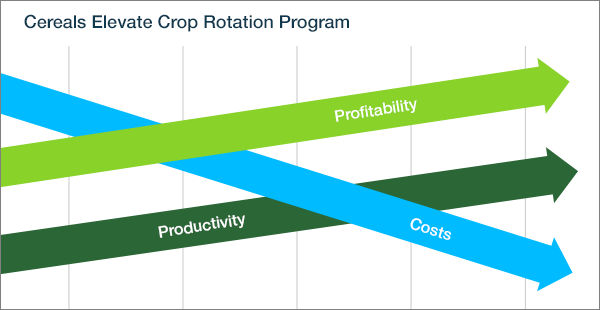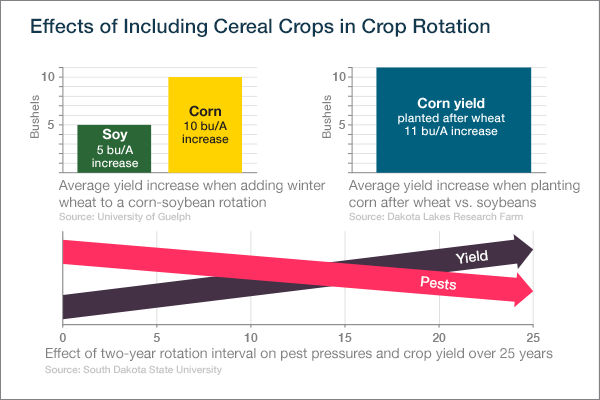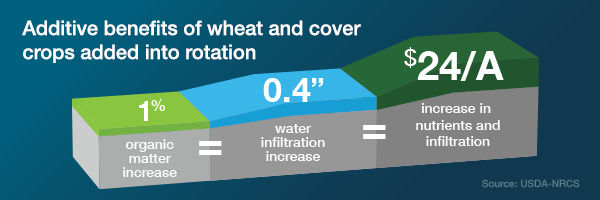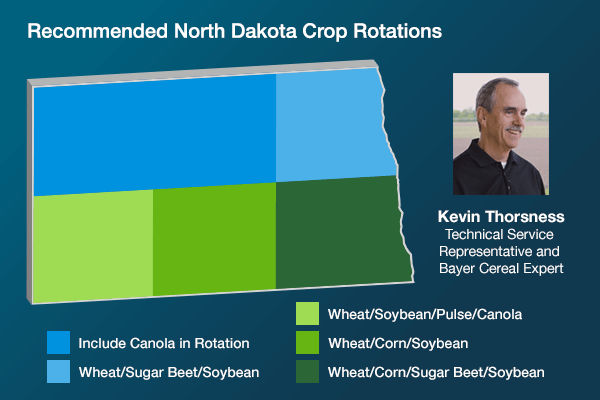Cereals Elevate Your Crop Rotation Program
March 14, 2019

Adding diversity to your crop rotation will minimize problems with weeds, diseases and other agronomic issues
Continuous cropping or a limited crop rotation can leave fields open to weed and disease issues, even the development of resistance.
Crop rotations, especially in the Northern Plains, that include cereal crops such as wheat help break the cycle of problem weeds, diseases and insects. Integrating more crops into the rotation can lead to better yield and ROI opportunities, according to the Cereal Experts with Bayer.
“Crop rotation also helps spread your risk from weather disasters and allows growers to spread out their workload,” states Kevin Thorsness, Bayer technical service representative and one of the Bayer Cereal Experts.
The Dakota Lakes Research Farms adds that crop diversity spreads crop risks, manages weed populations, enhances the soil profile and reduces fixed machinery costs. In addition, less diversity leads to profitability issues like increased input and labor costs.
Crop rotation and weeds
Crop diversity allows growers to rotate herbicide sites of action when managing weeds. Less diversity and use of the same herbicides leads to a greater chance of developing resistance.
“Ultimately [crop rotation] brings more sites of action to the acre over time versus relying on a narrow selection of products,” Thorsness said. As the popularity of soybeans with the glyphosate-resistant trait grew in the Northern Plains, so did the dependence on just a single herbicide for weed control. This led to an increase in glyphosate-resistant weeds like kochia, common ragweed, and tall waterhemp.
Cereal crops often incorporate different herbicide sites of action compared to crops with herbicide-resistant traits. A crop plan that incorporates a diverse crop rotation lets growers use other herbicides rather than relying on the same herbicide groups year after year. For example, Huskie® (Group 6 and 27) and Huskie Complete (Group 2, 6 and 27) have a combination of herbicide sites of action effective in wheat. If growers are continuously using the same sites of action for other crops in their rotation, Huskie and Huskie Complete help break the cycle that can otherwise lead to resistant weeds.
Herbicides with one Group or site of action should be used as part of an integrated weed management plan. That allows the grower to apply tankmixes with more Groups or rotate between Groups on the same population.
“Varro® is a Group 2 herbicide that is used in wheat. It has a favorable rotational profile for canola and pulse crops. Wolverine® Advanced contains Groups 1, 6, and 27 herbicide sites of action. It is useful for rotations that may include wheat two out of every four years. It could be a useful herbicide in rotation with Varro and Huskie Complete,” explained Thorsness.
According to Thorsness and other Bayer Cereal Experts, some cereal crops compete with weeds better than other crops, especially row crops. Cereals are planted in narrow rows with a high plant population compared to corn and soybeans which are often planted in wider rows. This creates a dense crop canopy, creating a more difficult environment for weeds to emerge. “Canola is also very competitive with problematic weeds,” he said.
Crop rotation and diseases
Bayer Cereal Experts advise growers to be careful in selecting the right crop rotation with cereals. Some crop rotations could result in higher disease pressure in cereal crops. According to the South Dakota State University (SDSU) Extension, a three-year, no-till rotation of spring wheat, winter wheat and corn increases the risk of Fusarium head blight (FHB) in wheat.
“Most growers avoid planting wheat after corn due to the increased risk of FHB,” said Thorsness.
To reduce the FHB risk, SDSU Extension recommends planting wheat after a broadleaf crop such as soybean. If growers don’t choose to alter this rotation, SDSU recommends growers scout thoroughly and monitor the weather conditions during the season and consider using a fungicide to keep FHB at bay.
If growers choose the fungicide route, Thorsness recommends using Prosaro® for their cereal crops. He says Prosaro has broad-spectrum control of diseases like FHB and general leaf disease to help growers maximize yield, improve grain quality and increase profit potential. “Prosaro is in a class of its own. Ultimately, Prosaro can help increase profitability on the cereal acre,” he said.
Planting wheat back into wheat residue can increase the risk of ergot because ergot bodies can remain viable for a year. Additionally, according to Thorsness, wheat-on-wheat rotations can also increase the risk for tan spot and other fungal leaf spot diseases. All of these situations will result in reduced grain quality and lower yield.
“A canola-wheat-pulse crop rotation will have less tan spot and FHB than a continuous wheat-wheat-wheat rotation,” said Thorsness. “Plus, cereals in a crop rotation with pulse crops reduce the risk of a yield-limiting disease such as ascochyta blight. Other crops such as sugar beets need a rotational crop like wheat or barley to help manage Rhizoctonia root rot and Cercospora leaf spot (CLS).”
Continuous soybeans can lead to increased risk of white mold and nematodes. “Growing soybeans year after year can result in soybean cyst nematode (SCN) populations that make it difficult, if not impossible, to profitably grow soybeans,” Thorsness added.
Crop rotation and insects
Insects in wheat are somewhat limited in the Northern Plains, according to Thorsness. However, wireworms have been more problematic in recent years. He says a diverse crop rotation will help with the management of wireworms. “Wireworms can become more problematic if wheat is not rotated with a non-susceptible host crop,” said Thorsness.
He recommends using a seed treatment such as Raxil® PRO Shield along with a crop rotation program that includes a non-susceptible host crop to help combat wireworms.
Baythroid® XL also can help manage other insects associated with cereals. “Baythroid XL is helpful in the management of wheat stem maggot when applied early season with a herbicide. It is also helpful in the management of aphids, which can transmit barley yellow dwarf virus (BYDV) when applied late season with Prosaro,” Thorsness added.
Cereal crop rotation resources
The Dakota Lakes Research Farm has developed a guide to help growers create a crop rotation program, with cereal crops, that is appropriate for their farming operation.
For more insights on cereal crops like the benefits of a diverse crop rotation, contact your local Bayer Cereal Expert or visit CerealExpert.com. Contact your local Bayer retailer for solutions to manage weeds, diseases and insects.
Boosting Yield Through Crop Rotation

Crop rotations with cereal crops often help increase the yields for both cereal and non-cereal crops.
South Dakota State University (SDSU) research over a 25-year period revealed that wheat yields improved – and pest pressures dropped – when the crop rotation interval between wheat crops is at least two years.
In particular, winter wheat is a very good crop to add in a corn-soybean rotation. According to the University of Guelph, adding winter wheat to a corn-soybean rotation resulted in a 10 bu/A average increase for corn and a 5 bu/A average increase for soybeans.
Research by the Dakota Lakes Research Farm reinforces the effect of wheat on corn yields. Results showed planting corn in wheat stubble increased corn yield by an average of 11 bu/A more than corn following soybeans.
Crop Rotation with Cereals Boost Soil Quality, Lowers Costs

Crop rotation diversity has benefits across the farm beyond weed, disease and insect management.
For instance, incorporating wheat plus a cover crop into the rotation can help reduce compaction. Less compaction enables better nutrient uptake and water infiltration, which creates conditions that could boost yield for each crop in the rotation.
A diverse crop rotation that includes wheat and a cover crop also enhances soil health by increasing organic matter, even in sandy soils. Even by itself, wheat can help increase soil tilth and water infiltration. According to the USDA Natural Resources Conservation Service, a 1 percent increase in organic matter increases water infiltration by 0.4 inches, which is equal to $24/A in increased nutrients and infiltration. In fact, the Dakota Lakes Research Farm indicated the cost of a corn-soybean-wheat rotation – plus cover crop – would be 50 percent less than the cost of just a corn-soybean rotation.
According to SDSU, a well-planned crop rotation with a cereal crop like wheat helps growers reduce fixed machinery and labor costs and better allocate time spent on fieldwork like planting, spraying and harvesting across the different crops. Additionally, growers can diversify their income and spread weather risks across the full crop rotation.
North Dakota Crop Rotations

Bayer Technical Service Representative and Cereal Expert Kevin Thorsness offers crop rotation recommendations that can lead to higher yields and better management of weeds, diseases and other production issues.
Eastern North Dakota. Wheat is often in a sugar beet/soybean/corn rotation. If the grower raises sugar beets, then wheat is often grown the year before sugar beets. Corn can also be a big part of the rotation. Wheat is rarely grown after corn. Dry beans and potatoes can also work into the mix.
Central North Dakota. Wheat is in more of a corn/soybean rotation. Again, most growers avoid planting wheat after corn.
Western North Dakota. Include wheat in a soybean/pulse/canola and maybe corn rotation. Although it is not the best practice, it is still common in some areas to rotate wheat on wheat.
Northern North Dakota. Canola becomes a big part of the rotation along with pulses and soybeans.
© 2019 Bayer Group. Always read and follow label instructions. Bayer, the Bayer Cross, Baythroid, Huskie, Prosaro, Raxil, Varro and Wolverine are registered trademarks of Bayer Group. Baythroid XL and Huskie Complete are Restricted Use Pesticides. Not all products are registered in all states. For additional product information please call toll-free 1-866-99-BAYER (1-866-992-2937) or visit our website at www.CropScience.Bayer.us. Bayer CropScience LP, 800 North Lindbergh Blvd., St. Louis, MO 63167.
CR1218MULTIPB546S00R0